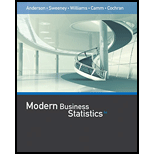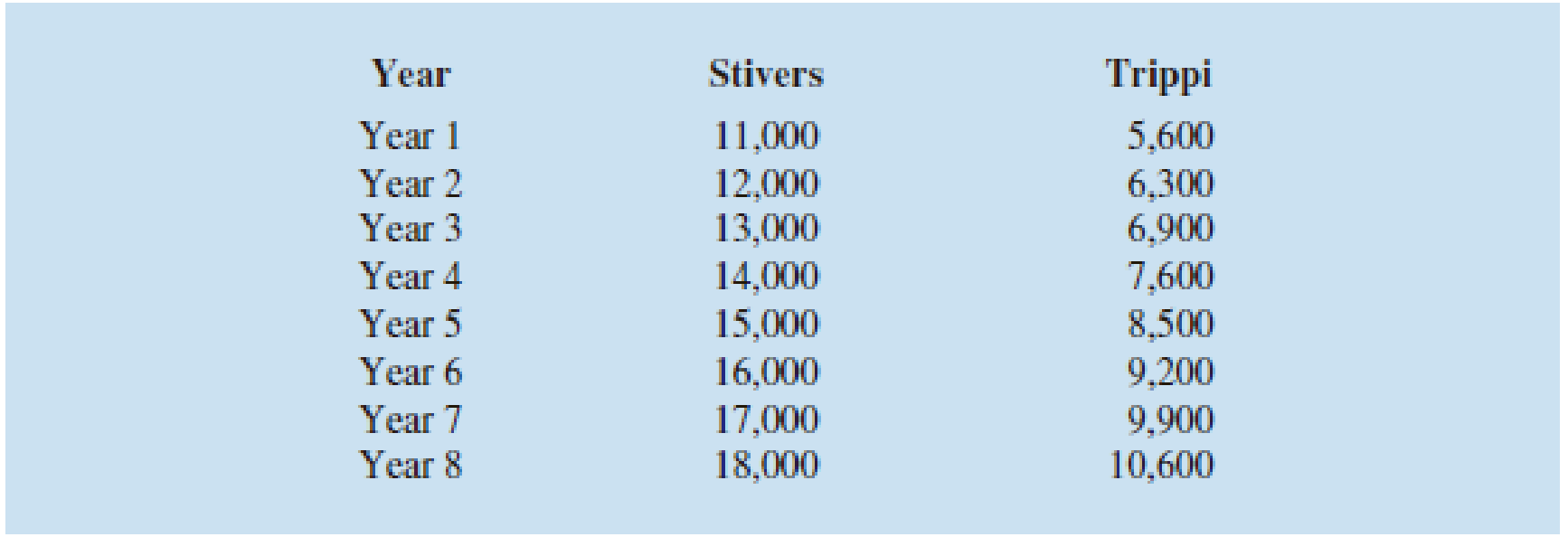
Concept explainers
Suppose that at the beginning of Year 1 you invested $10,000 in the Stivers mutual fund and $5000 in the Trippi mutual fund. The value of each investment at the end of each subsequent year is provided in the table below. Which mutual fund performed better?

Identify the mutual fund that performed better.
Answer to Problem 20E
The Trippi mutual fund performed better than Stivers.
Explanation of Solution
Calculation:
In the Stivers mutual fund, $10,000 is invested at the beginning of Year 1 and in Trippi mutual fund, $5,000 is invested at the beginning of Year 1. The given table represents the value of each investment at the end of each subsequent year.
The geometric mean is often used for finding the mean growth rate.
The mean growth factor over these eight periods is:
Where,
The growing factor of each year can be obtained by dividing the value of end of year by the previous year value.
The growth factor of Stivers for the year 1 can be obtained as follows:
The growth factor of Trippi for the year 1 can be obtained as follows:
Similarly the growth actor for remaining years can be obtained as shown in the table given below:
| Year | Stivers | Trippi | ||
| End of Year Value | Growth Factor | End of Year Value | Growth Factor | |
| 1 | $11,000 | 1.100 | $5,600 | 1.120 |
| 2 | $12,000 | 1.091 | $6,300 | 1.125 |
| 3 | $13,000 | 1.083 | $6,900 | 1.095 |
| 4 | $14,000 | 1.077 | $7,600 | 1.101 |
| 5 | $15,000 | 1.071 | $8,500 | 1.118 |
| 6 | $16,000 | 1.067 | $9,200 | 1.082 |
| 7 | $17,000 | 1.063 | $9,900 | 1.076 |
| 8 | $18,000 | 1.059 | $10,600 | 1.071 |
For the Stivers mutual fund:
The balance at the end of the year 8 is the initial investment times the product of all 8 growth factors.
That is,
Substitute
Thus, the mean annual return for the Stivers mutual fund is
For the Trippi mutual fund:
The balance at the end of the year 8 is the initial investment times the product of all 8 growth factors.
That is,
Substitute
Thus, the mean annual return for the Trippi mutual fund is
The annual return earned by the Trippi mutual fund is 9.8% and by the Stivers mutual fund is 7.6%. Hence, the annual return earned by the Tripp mutual fund is more than that of Stivers mutual fund.
Thus, it can be concluded that the Trippi mutual fund performed better than Stivers.
Want to see more full solutions like this?
Chapter 3 Solutions
Modern Business Statistics with Microsoft Office Excel (with XLSTAT Education Edition Printed Access Card) (MindTap Course List)
- Examine the Variables: Carefully review and note the names of all variables in the dataset. Examples of these variables include: Mileage (mpg) Number of Cylinders (cyl) Displacement (disp) Horsepower (hp) Research: Google to understand these variables. Statistical Analysis: Select mpg variable, and perform the following statistical tests. Once you are done with these tests using mpg variable, repeat the same with hp Mean Median First Quartile (Q1) Second Quartile (Q2) Third Quartile (Q3) Fourth Quartile (Q4) 10th Percentile 70th Percentile Skewness Kurtosis Document Your Results: In RStudio: Before running each statistical test, provide a heading in the format shown at the bottom. “# Mean of mileage – Your name’s command” In Microsoft Word: Once you've completed all tests, take a screenshot of your results in RStudio and paste it into a Microsoft Word document. Make sure that snapshots are very clear. You will need multiple snapshots. Also transfer these results to the…arrow_forward2 (VaR and ES) Suppose X1 are independent. Prove that ~ Unif[-0.5, 0.5] and X2 VaRa (X1X2) < VaRa(X1) + VaRa (X2). ~ Unif[-0.5, 0.5]arrow_forward8 (Correlation and Diversification) Assume we have two stocks, A and B, show that a particular combination of the two stocks produce a risk-free portfolio when the correlation between the return of A and B is -1.arrow_forward
- 9 (Portfolio allocation) Suppose R₁ and R2 are returns of 2 assets and with expected return and variance respectively r₁ and 72 and variance-covariance σ2, 0%½ and σ12. Find −∞ ≤ w ≤ ∞ such that the portfolio wR₁ + (1 - w) R₂ has the smallest risk.arrow_forward7 (Multivariate random variable) Suppose X, €1, €2, €3 are IID N(0, 1) and Y2 Y₁ = 0.2 0.8X + €1, Y₂ = 0.3 +0.7X+ €2, Y3 = 0.2 + 0.9X + €3. = (In models like this, X is called the common factors of Y₁, Y₂, Y3.) Y = (Y1, Y2, Y3). (a) Find E(Y) and cov(Y). (b) What can you observe from cov(Y). Writearrow_forward1 (VaR and ES) Suppose X ~ f(x) with 1+x, if 0> x > −1 f(x) = 1−x if 1 x > 0 Find VaRo.05 (X) and ES0.05 (X).arrow_forward
- Joy is making Christmas gifts. She has 6 1/12 feet of yarn and will need 4 1/4 to complete our project. How much yarn will she have left over compute this solution in two different ways arrow_forwardSolve for X. Explain each step. 2^2x • 2^-4=8arrow_forwardOne hundred people were surveyed, and one question pertained to their educational background. The results of this question and their genders are given in the following table. Female (F) Male (F′) Total College degree (D) 30 20 50 No college degree (D′) 30 20 50 Total 60 40 100 If a person is selected at random from those surveyed, find the probability of each of the following events.1. The person is female or has a college degree. Answer: equation editor Equation Editor 2. The person is male or does not have a college degree. Answer: equation editor Equation Editor 3. The person is female or does not have a college degree.arrow_forward
 Intermediate AlgebraAlgebraISBN:9781285195728Author:Jerome E. Kaufmann, Karen L. SchwittersPublisher:Cengage Learning
Intermediate AlgebraAlgebraISBN:9781285195728Author:Jerome E. Kaufmann, Karen L. SchwittersPublisher:Cengage Learning Algebra for College StudentsAlgebraISBN:9781285195780Author:Jerome E. Kaufmann, Karen L. SchwittersPublisher:Cengage Learning
Algebra for College StudentsAlgebraISBN:9781285195780Author:Jerome E. Kaufmann, Karen L. SchwittersPublisher:Cengage Learning Holt Mcdougal Larson Pre-algebra: Student Edition...AlgebraISBN:9780547587776Author:HOLT MCDOUGALPublisher:HOLT MCDOUGAL
Holt Mcdougal Larson Pre-algebra: Student Edition...AlgebraISBN:9780547587776Author:HOLT MCDOUGALPublisher:HOLT MCDOUGAL
 Trigonometry (MindTap Course List)TrigonometryISBN:9781337278461Author:Ron LarsonPublisher:Cengage Learning
Trigonometry (MindTap Course List)TrigonometryISBN:9781337278461Author:Ron LarsonPublisher:Cengage Learning





